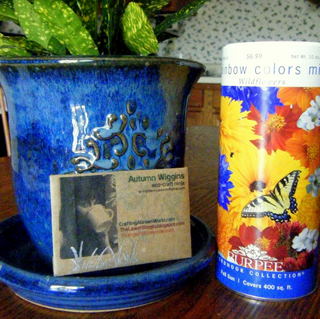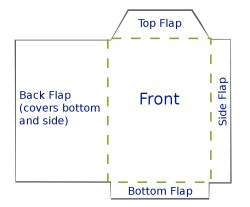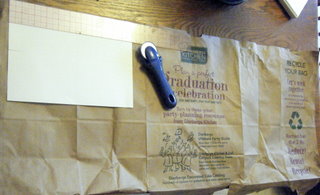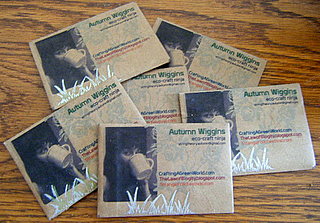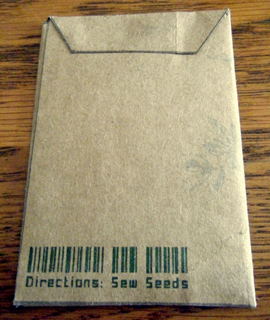Gather your materials and ideas. Here’s what’s involved:
An inkjet printer The seed packet outline template (download here in JPG or PDF file formats) Embellishment option 1: A graphics program such as Adobe Photoshop or GIMP (free open-source software) Embellishment option 2: Decorate the packet post-printing by hand Embellishment option 3: Do both! Paper grocery bags Iron and scrap fabric Scissors Ruler Pencil Glue stick Paper creaser or popsicle stick 1 can of wildflower seeds Optional: rotary cutter with dedicated blade Optional: stamps, stickers or other embellishments(as long as they don’t poke holes in the paper)
Create your design
You need only a basic knowledge of manipulating graphics to create a design with the template. Don’t fret over acquiring Photoshop if you don’t own it. I have been singing the praises of open-source options like GIMP and Inkscape for years now. If you are not adept to using this type of software, no worries! You can simply print the PDF file, then write, collage, stamp, or glue to your heart’s content. Here is a brief description of the steps I take using GIMP(for all you rookies): Open the template in your program. It’s 150dpi, and is sized to print at 8.5″x11″. You’ll want to work in layers for manipulating different elements. Create your design within one of the outlines. When you are done, save it in the native format(.psd for Photoshop or .svg in GIMP), so you can adjust later if needed. Now, simply merge down those layers, leaving the background free. Copy/paste the text and images, and align them on to the second packet outline (or do different designs, it’s your party!). Keep in mind that printing on brown paper means that white will not be a factor in your colors. They will be duller than what appears on the screen. That said, I have an inexpensive multi-function HP printer, and even light blue showed up nicely. Important text should be in bold or dark colors though, and keep it about 1/4″ from the fold lines as well. When you print, make sure to check the options for margins. If you can, set the printer to ignore them.
Turn bags into printer paper
All paper grocery bags that I’ve encountered have a single seam along the length of one side. You don’t want to print on seams, so rip or cut it open along that line. You won’t be using the bottom. Cut it out, or tear it apart so that the bag lays flat in a single layer. The point is to have as much surface area as possible to divide into 8.5″x11″ pieces. Using a scrap piece of printer paper as a template, place a ruler around the edges and trace/cut or rotary cut out individual pages. Yes, it’s against all convention to use your sewing cutlery on paper, but buy a dedicated blade for your rotary cutter, and I promise you’ll find it enormously useful for this and other projects. I made 3o Japanese stab bound books for Christmas presents last year, and opted to make this tool multi-use rather than buying a dedicated paper cutter. This also allows you to stack up to 3 layers of bags that you can cut through in one pass. For a standard size bag, you’ll get about 6 sheets of paper(12 packets). Once you have your sheets cut out, they will probably be somewhat wrinkly. So, we’re going to crossover to our sewing supplies again, and using a piece of scrap fabric as a buffer, iron out the sheets on med-high heat one at a time. This will help them to go through the printer smoothly, and make a nicer finished product.
Tips on printing
I think buying packaged specialty papers is to your printer as packaged patterns are to your sewing machine. It creates a predictable finished product, but both of these machines are potential avenues for experimentation. I have had no problem sewing through cardboard. Likewise, I’ve had no problem printing on regular fabric. More on that later, but let’s stick with the program. Load your paper bag paper with the blank side in the correct direction to be printed on in the paper tray. Keep the cleanest edge (one with the least folds or wrinkles) on the feed side. If you are printing your design, set your printer properties to a high-quality setting, and adjust the ink volume to medium-heavy or heavy. I got over 75 cards printed without putting too much of a dent in my notably puny cartidges. Print a sample or two, and adjust as needed. When trying this, I was pleasantly surprised by the sharpness of the images on the seemingly rough surface. I had one or two jams, but they were because I was messing around with the loading tray. No big deal. Again, I have a run-of-the-mill, front loading HP, any inkjet should work similarly. If you try, this and have any particular issues or tips for your model, please leave them in comments.
Cut, paste, and plant!
Cut out the individual packets along the lines. If you want to add additional decoration or hand drawings, now is the time. With the right side down, fold all the flaps in towards the middle, and crease using your popsicle stick or paper creaser(sometimes these are called “bone folders” though they are generally made from plastic nowadays). glue the large side flap over the top of the folded in bottom (the tapered end is the top) and opposite side flap. I find they stick better if you apply the glue to both surfaces being stuck together. Press and smooth out to seal, then let dry completely. Give them at least a few hours to set, then pour a tablespoon or so of seed mixture into the open end, and apply glue to both the flap, and packet surface to thoroughly seal. Smile about all random acts of guerrilla gardening you are setting into motion : ) I want you guys to be able to go nuts with this idea. So I’m releasing it under a Creative Commons license. That means you may “perform”, tweak, and publish this tutorial to your hearts content, even for commercial purposes. The only requirement is that you should acknowledge its use anywhere you might republish or showcase a derivative product online by linking back to craftingagreenworld.com. Here are just a few possibilities for hobbyists and entrepreneurs alike:
Enlarge the template image and use for packaging larger trinkets and such.
Are you a gardening enthusiast? Package your own seeds! Keeping them sealed in a cool, dry place should prevent any random sprouting. I’ve had no problem whatsoever with that.
Do you make and sell items for gardeners? This would be a great addition to a gift set.
Make them into tags by taping a loop of scrap paper on the back to attach with a string.
What else could you put in them? Emergency sewing kits? A small beading project? Surprise collectible pin-backs? Trading cards? Product samples?
Try sticky velcro to seal the top for larger reusable contents.
Go ahead, escape the the force of craft gravity. The sky is no longer the limit. This attribution requirement only applies to the fabrication described in my tutorial. You may attach your own copyright preference to any original imagery or artwork you apply in the process. Sponsored link: If you find yourself needing to print your business cards in the future, pay our PsPrint a visit. You’ll definitely save lot on your printing services and get excellent business cards without spending a lot. Brown Paper Seed Packet Business Cards by Crafting a Green World – Autumn Wiggins is licensed under a Creative Commons Attribution 3.0 United States License.
